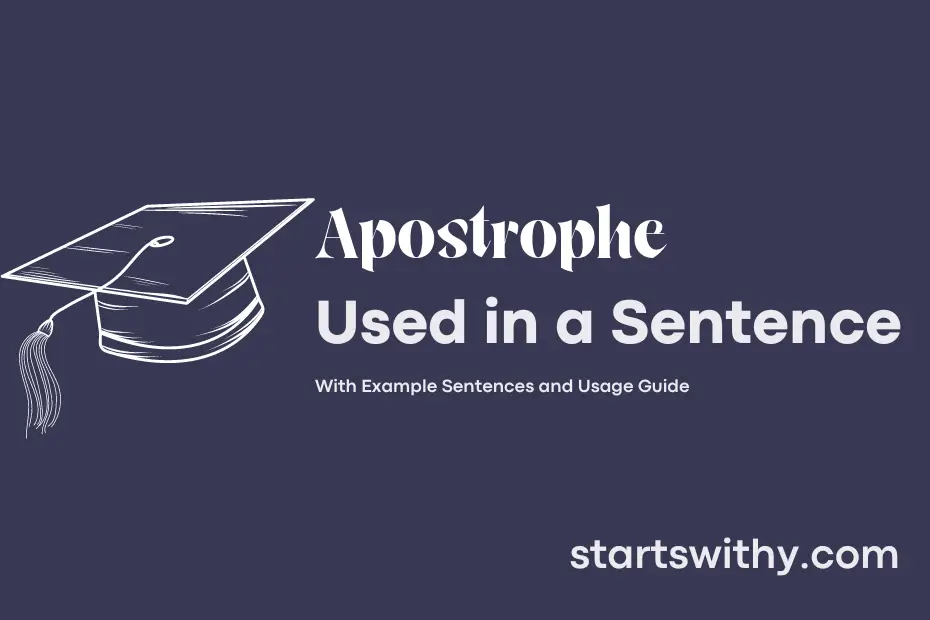Have you ever wondered how to correctly use an apostrophe in your writing? An apostrophe is a punctuation mark often misused but essential for indicating possession or forming contractions in English.
Using apostrophes can sometimes be tricky, but with a few simple rules, you can easily master their proper use. Let’s explore the correct ways to incorporate apostrophes in your sentences and avoid common mistakes.
7 Examples Of Apostrophe Used In a Sentence For Kids
- My apostrophe friend helps me make contractions.
- The apostrophe shows when a letter is missing.
- I like to put an apostrophe in words like can’t and don’t.
- Our class learned how to use an apostrophe in words like they’re and we’re.
- Can you find the apostrophe in the word didn’t?
- The apostrophe makes words shorter and easier to say.
- Remember to use an apostrophe in words like it’s and I’m.
14 Sentences with Apostrophe Examples
- Apostrophe should always be used in contractions like “can’t” and “won’t”.
- It is important to know when to use apostrophes in possessive nouns.
- Remember to place the apostrophe before the “s” in singular possessive nouns.
- When showing possession with plural nouns, place the apostrophe after the “s”.
- Make sure to use apostrophes properly when writing dates like “today’s lecture”.
- Don’t forget to include apostrophes in abbreviations like “I’m” for “I am”.
- The word “it’s” with an apostrophe means “it is”, while “its” without an apostrophe shows possession.
- Use apostrophes in expressions like “India’s Independence Day”.
- Check your essays for correct apostrophe usage to avoid losing marks.
- Knowing when to use apostrophes can improve the readability of your writing.
- Practice using apostrophes correctly in your assignments to build good writing habits.
- Pay attention to the placement of apostrophes when editing your work.
- Use apostrophes in your citations to properly credit the authors you reference.
- Understanding how to use apostrophes will enhance the clarity and professionalism of your academic writing.
How To Use Apostrophe in Sentences?
Apostrophe is a punctuation mark that serves multiple purposes in the English language. Here is a guide for beginners on how to use apostrophe correctly in a sentence:
-
Possessive Case: The most common use of apostrophe is to show possession. When something belongs to someone or something else, use an apostrophe followed by an “s.” For example, “John’s book” shows that the book belongs to John.
-
Contractions: Apostrophes are used in contractions to indicate where letters have been omitted. For example, “can’t” is a contraction of “cannot,” and the apostrophe shows where the “no” is missing.
-
Plural Possessive: When showing possession for words that are plural, the apostrophe is placed after the “s.” For example, “the students’ projects” indicates that the projects belong to more than one student.
-
Avoiding Confusion: Apostrophes can be used to clarify meaning and avoid confusion. For example, “its” is the possessive form of “it,” while “it’s” is a contraction for “it is.”
Remember, misuse of apostrophe can change the meaning of a sentence, so pay close attention to where it is placed. Practice using apostrophes in different contexts to become comfortable with this punctuation mark and improve your writing skills.
Conclusion
In writing, sentences with apostrophes are commonly used to indicate possession or contraction. Apostrophes help clarify relationships between words by showing ownership or shortening words by omitting letters. They play a crucial role in ensuring clear and concise communication in written language.
By correctly using apostrophes in sentences, writers can avoid confusion and convey their intended meaning effectively. It is important to be familiar with the rules of apostrophe usage to maintain clarity and precision in writing. Remembering to use apostrophes where necessary can elevate the quality of writing and help readers better understand the relationships between words.



